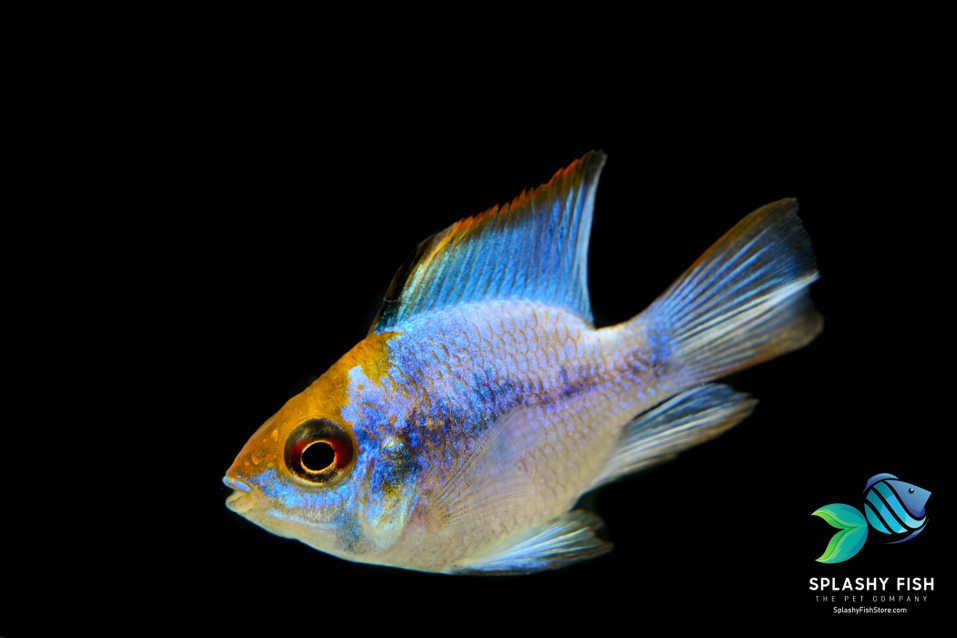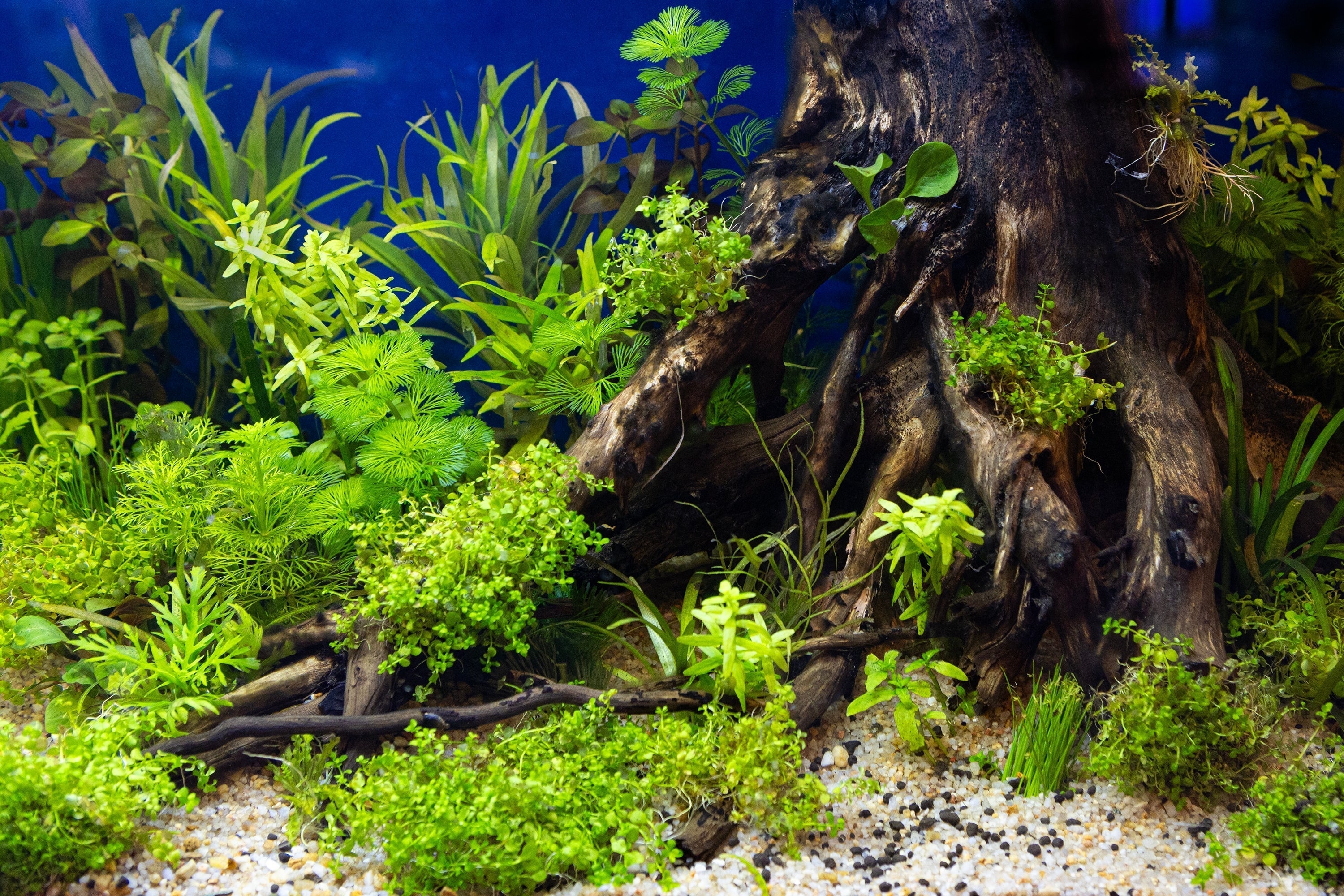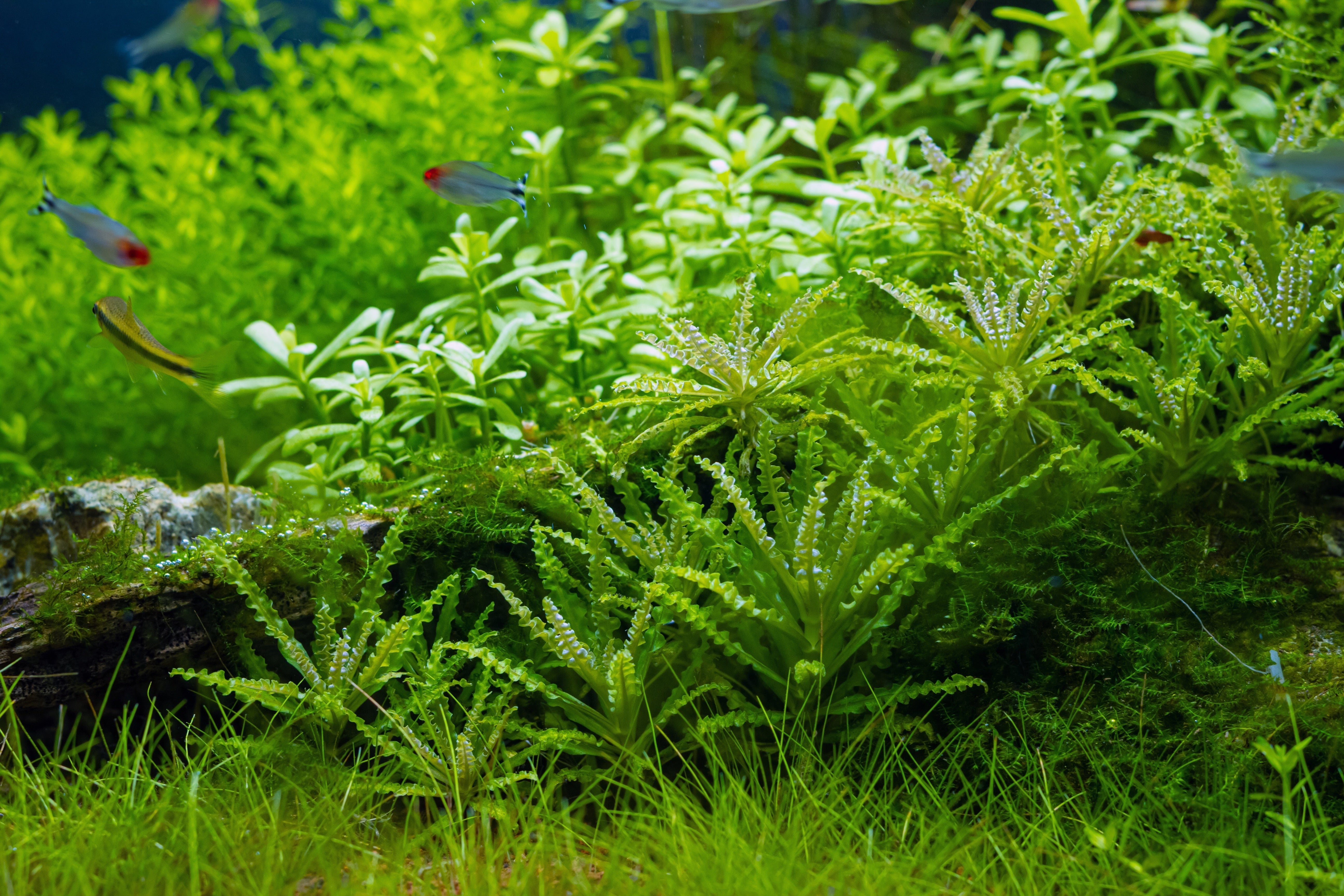Table of Contents
Attract your attention at the first sight by its vivid iridescent blue body, German Blue Ram (scientific name: Mikrogeophagus ramirezi), is absolutely a colorful hit to your aquarium.

The little beauties feature themselves with gold/silver coloration and electric blue dots over their body. Black markings are sometimes found near the head and along their upper fins, while slight red or orange tends to focus on their fins’ tip. Females have a shimmering pink belly and are relatively smaller compared to males. Their body is more oval with pointed tail and fins. Generally, an adult German Blue Ram can reach the maximum size of 2-2.5 inches (5-6 cm) long. Such size together with their charming appearance surely defeat all other species to become the focal point of your tank.
German Blue Ram is a cichlid species and native to South America (mainly in Orinoco River basin located in both Venezuela and Colombia). There resides shallow pools and streams containing sandy beds and abundant vegetation, the favorite refuges of German Blue Ram also where they are largely discovered.
Randomly visiting a fish store, you may easily encounter many German Blue Ram specimens originating from different sources, including both the wild-caught and the captive-bred ones. Most fishkeepers believed the captive-bred species exhibit intense and more color variations thanks to many selective breedings. Some asserted that we can rely on their color display to tell them apart, as the wild-caught fish tend to have more visible black markings than the captive-bred specimens.
Purchase tips: As when you choose other fish directly at a fish store, take a look around the containers and go for a robust, active German Blue Ram. Do not consider the specimen that is skinny or have a hollow belly as this may indicate that the ram has health problems. Since it is regarded as a demanding species in terms of care, if you choose the sick ram, it may take you a lot of effort to cure the fish in addition to maintaining the standard living environment. Moreover, rare reports show such ram can recover from these symptoms.

Although they are adorable, they are not easy to keep and strongly not recommended for both beginners and intermediate hobbyists. The reason behind this warning is simple: German Blue Ram is extremely sensitive to water parameters to the extent that even a minor change in their living conditions can badly affect their health. Therefore, if you are not confident of your fish-caring skills, you’d better not take them home.
German Blue Ram will be contended with the following water conditions.
Ammonia and Nitrite: 0 ppm
Nitrate: less than 20 ppm
GH: 6 - 14 dGH
KH: 2 – 10 dKH
pH: 6 – 7
Water change: 10% to 20% once a week because German Blue Ram needs good water quality to thrive.
Oxygen and temperature range should be monitored to imitate their natural habitats. According to most aquarists, their favorite warm range normally falls between 74° - 82°F (23° - 28°C). They like being surrounded with plenty of plants, which accidentally creates moderate to subdued lighting conditions. Hence, if your room is full of light, you may not need to equip your tank with lighting devices/ systems. German Blue Ram is familiar with slow to moderate water currents, which are also the natural trait of South America’s rivers and streams. If you have a strong filter, try to adjust it to generate your desired flows.
Live aquatic plants are another “member” that cannot be missed in German Blue Ram tanks. The fish appreciate heavily planted aquariums which can provide lots of hiding places for them to play with or conceal from aggressive creatures. You can consider adding driftwood or rock caves since it can kill two birds with one stone, create more shelters as well as produce a natural landscape for your tank. When choosing live plants, go with those species which can endure the similar living conditions to that of German Blue Ram, such as Java Fern, Amazon Sword, Wisteria and Mosses; and arrange them in a way that leaves some space for your fish to hang around.
With lots of things put into the aquarium, one may wonder: “what is the appropriate tank size for keeping German Blue Ram?” Typically, a 20-gallon tank can hold well a pair of German Blue Rams provided that you don’t stock much of other species. Following the rule, you will need to increase your tank size if you keep more than that number, for example 40 gallons for two pairs of German Blue Rams. In case you raise them for the purpose of breeding, you can opt for a smaller size like a 10-gallon for just keeping them only. Nonetheless, whichever tank size you consider, always remember that hiding places and free space play important roles to decide their happy life, especially when you keep more than one ram. In this situation, one of them may often show its dominance over the other. Hence, more space and hiding places could create “buffer zones'' for them to avoid such conflicts.
Another important note that every German Blue Ram keeper must learn by heart is that this fish should NOT be introduced to a newly cycled tank. These tank environments may not be stable, which easily adversely affect your fish health. Regular testing is highly encouraged to perform as it can tell if the tank water is still in good quality.

Most cichlids appear to be aggressive; however, German Blue Ram is on the other hand. They are known for their peaceful and easy-going dispositions. Only a few of them show territorial behaviors toward other same-species, and most occasions are when you keep them together in a small area. To prevent this, you can put the belligerent ram into a separate tank so he can become the boss as he wishes. German Blue Ram can live alone as long as you provide them with the standard habitats. They spend most of their time splashing around or digging the substrate. Their electric blue coloration then would lighten your tank in an unexpected way.
Since they like to dig, a mix of gravel and sand couldn’t be a more perfect substrate to your ram tank. Be careful of not choosing the sharp-edged gravels; or else, they may cause your fish to be injured.
As a peaceful species, German Blue Ram could get along well in fish community tanks. Good neighbors could include non-cichlids and peaceful dwarf cichlids such as silver dollars, dwarf gouramis, discus, plecostomus catfish, cardinal, neon tetras, corydoras, rummynose tetras, kuhli loaches, clown loaches, guppies, mollies, and platies. Nevertheless, you should be cautious if your aquarium contains species that are small enough to fit into ram’s mouth since they tend to be the potential prey to German Blue Ram.
When it comes to diet, German Blue Ram, amazingly, is not a picky eater at all. The fish are omnivores and can accept various types of high-quality fish food like brine shrimp, bloodworms, fish flakes and sinking pellets. You should further add some vegetables and plants occasionally to keep its diet balanced and ensure it gets all the essential nutrients and vitamins it needs to stay healthy. Feed them once or twice a day is necessary. It is believed that the latter benefit your rams especially when they are growing up while the former is usually applied for adult specimens. Follow a good rule of thumb that feed them the amount sufficient enough for them to consume within 2-3 minutes, and remove all leftover food after that time. It helps maintain the good quality of the tank water as well as not overfeed your rams. Try to spread the food over the water surface when feeding to ensure your fish can approach their meal, particularly if they are kept in community tanks.
A balanced diet with appropriate and clean living conditions are main factors to prolong the lifespan of German Blue Ram. If you can meet their requirements, your rams will stay with you for up to 4 years.
At Splashy Fish Store, we supply a wide range of German Blue Ram which come from reliable sources. We further guarantee that all of our German Blue Ram will go through the quarantine process for a period of 14-day before sale. We care about the quality and strive to provide you the best we can. Visit our store to find what surprise is waiting for you.


























